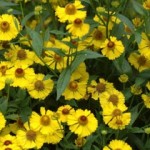- Gardens that look good in fall work well all year long, gardeners in-the-know often say.
Many native plants tend to be deep-rooted, strutting their stuff, their blooms, in late summer and fall. These include asters, coneflowers, sunflowers, sneezeweed, bergamot, milkweeds, blazing stars, goldenrods, culver’s root, turtleheads, Joe Pye weed, cup plant, compass plant, wild senna and grasses such as big and little bluestem.
Other deep-rooted perennials offering earlycolor and interest include false indigo, sweet flags, irises, penstemons, celandine poppies and meadowsweet.
Using native plants in rain gardens, bioswales, prairie and wildflower gardens maximizes sustainability because they are tough, hardy and reliable. The gardener using native plants lowers the risk of losing plant stock during drought. Because many of these plants are so adaptable, they often weather rainy springs and winters common in our part of the country.
Other drought-tolerant plants include dry denizens such as Russian sage and other sages, lamb’s ears, sedum, hens-and-chicks, daylilies, and the long line of clumping, spreading plants that work well in herb gardens: lavender, rosemary, yarrow, artemesia, hyssop, oregano, thyme, catmint and calamint. Fragrant plants also have an advantage; they’re not popular with deer, which can’t stand their smelly aroma.
Gardening doesn’t have to mean buying expensive, high-maintenance, exotic plants that last only aseason or two. Don’t lose out; choose proven, adaptable performers that spread and stand up to adverse conditions.
- Helenium autumnale l. (sneezeweed)
- perovskia a. (russian sage)
- Aster novae-angliae (New England aster)







Leave A Comment